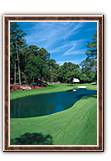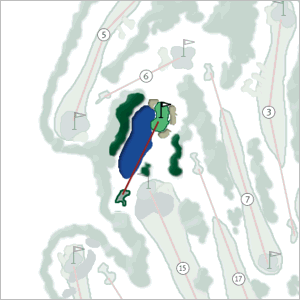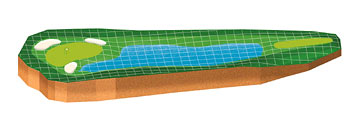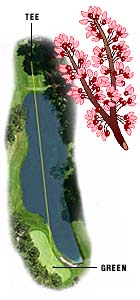| Hole Names | |
|
|
|

Hole #16RedbudCercis canadensis Par 3, 170 Yards |

|
||
|
The hole is played entirely over water, and the green is secured by three bunkers. With the green significantly sloping from right to left, an exacting tee shot is required to have a reasonable birdie opportunity. Carry is all over water to green that provides some treacherous pin positions. Carry is all over water to green that provides some treacherous pin positions. Green slopes sharply from right to left. The fairway is all water. The green has a little neck at the back of the green that sticks out to the left into the water. When the pin is there, it takes a desparate golfer to shoot for it. | |||

QuickTime AVI (3.55M) Animated GIF | |||
|
Jack Nicklaus says: One of those holes that you can take advantage of with only one pin placement, and that's back-left. All the other pin positions, you have to really be precise to get it close to the hole and have a chance for a birdie. Very tough green to putt. The 16th hole has been one of the kindest to me at Augusta National. More importantly, it has been a key to many of my victories. I typically hit a 6-iron here, but in 1986 the hole played 179 yards and there was a little breeze. I decided to hit a solid 5-iron. I remember my son, Jackie, saying after I hit it, “Be enough. Be enough.” I turned to him, winked, and said, “It is.” Although the front bunker didn’t allow us to see where the ball landed, I saw on video later that it missed the cup by a half-inch before stopping three feet away for a birdie. People also like to remind me of my “war dance” at 16 after I sank a 45-footer for birdie in the final round of the 1975 Masters. To this day, my down-the-stretch battle with Johnny Miller and Tom Weiskopf that year was one of the most thrilling shootouts in which I’ve ever been involved. The play here is to aim at the center of the green and work the ball in the direction of the flag. If the flag is right, I play a cut. If the flag is back left, I play a draw. If it’s back center, I try to hit it straight. With that strategy, I then try to pick the right club to match the distance. Fuzzy Zoeller says: This is a classy par 3, playing 150 to 185 yards. Players will hit anything from a 5 to a 9 iron here. The green has a big rise, it's protected by big bunkers and the lake. From the middle of the green it rises 3˝ feet to the back right. Tiger Woods says: Three distinct areas: a front-right, the whole bottom shelf, and a back right pin location. It requires a very concise tee shot to the front right and back right, but anything on the left you can use the slope to feed it in there. It's a hole where you can see a lot of 2s or see a lot of 4-putts. Fred Couples says: A great, great par-3. I believe (in 1998), they didn't really give us an easy pin spot on the left. They put it all on the right and back left on these ridges and I felt like the hole played very, very difficult. There weren 't very many birdies. You can hit a 5-, 6- or 7-iron -- it all depends if the pin is in the front or the back. A lot of times you just want to get it on the green, two putt and get out of there. It's a very difficult green. If you miss it to the right, you should play for a bogey. And if you try and get cute, you can make a double. Bernhard Langer says: Although No. 16 isn't a very long par 3, I consider its green just slightly less severe than the one at 14. The putting surface has a big ridge running through it lengthwise, with the right side high and the left side low. When the hole is positioned on the right, it's very difficult to get the ball to stay up there. And if you leave your shot right of the green, you're facing a tough recovery. One year, with the hole on the right side, I put my tee shot in the fringe to the right of the flag. I knew I couldn't putt toward the hole because it was simply too fast, so I putted uphill, away from the hole, and the ball trickled down pretty close for a great two-putt. This is one hole where you definitely want to play it safe off the tee, especially if you have the lead. On Sunday I like to draw a 6- or 7-iron to the traditional hole location in the green's back-left corner. If it goes straight, I'm safe and if it draws in, the result should be perfect. In 1993 I had the luxury of a four-shot lead, so I knew that if I parred in I wouldn't have any problems. I also made a great two-putt here on Sunday in 1985 to preserve a one-stroke lead.
| |||

Hole #16RedbudCercis canadensis Cercis canadensis is a small tree native to the Eastern United States. Commonly called the Judas tree, its flowers are orchid pink rather than red. It is a member of the Legume Family. The showy, small flowering tree blooms from early March into April. |

|
||
fatpat Software · PO Box 1785 · Charlottesville, VA 22902 · (804) 977-1652
